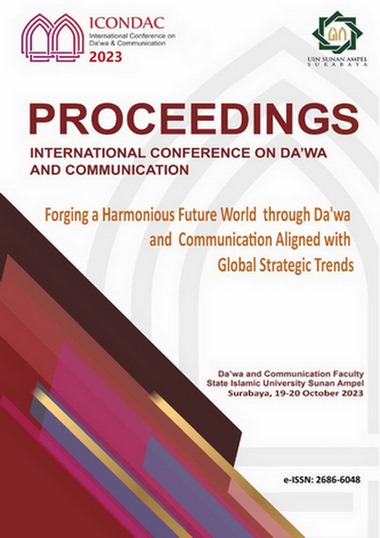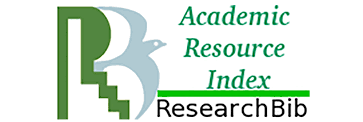A Communication Strategy for Promoting Halal Beauty Products
An Analysis of Syntactic Features
Abstract
Language is the most important component for a successful advertising products. This study aimed to analyze the language used of slogans in online advertisement which taken from halal beauty products based on the syntactic features. This study used descriptive qualitative as the research design and textual analysis was used to analyze the data. There were 61 data which were taken from the slogans of Wardah product advertisement. Based on the data analysis, it was found that there were short sentence (1 data), long-noun phrase (19 data), ambiguity (3 data), use of imperative (25 data), simple and colloquial language (1 data), use of present tense (1 data), syntactic parallelism (3 data), association (4 data), ellipsis (2 data), and incomplete sentence (2 data). The findings on the use of imperative became the most used feature in the slogans. The advertisement used imperative to persuade the consumers directly to follow the directions or instructions made in Wardah slogans.
Downloads
References
Aruan, Lilis Srirejeki, Corry Yohana, and Muhammad Yusuf. 2021. “Peran Merek Dalam
Bahasa Asing Dan Citra Merek Terhadap Keputusan Pembelian.” Riskesdas 2018 3, no. 2: 103–11.
Atmaja, Karta. 2022. “Internet Analysis of Figurative Language in Automotive
Advertisement Slogans”. Journal of Pragmatics Research 4, no. 1: 18–28. https://doi.org/10.18326/jopr.v4i1.1828
Fitria, Tira Nur. 2021. “Persuasive Strategies in Selected Brand Products’ Advertisement on
Instagram: Rationalization Aspect”. Journal of Pragmatics Research 3, no. 2: 108–130. https://doi.org/10.18326/jopr.v3i2.108-130
Fomukong, Seino & Agwa Evangeline. 2016. “ Stylistics Analysis in Advertising Discourse:
A Case of Dangote Cement Advertisement in Bamenda-Cameroon”. Advances in Language and Literary Studies, 07. 105-112.
Lasswell, Harold Dwight, Lerner, Daniel, & Speier, Hans. (1979). Introduction. In H. D.
Lasswell, D. Lerner, & H. Speier (Eds.), Propaganda and communication in world history: The symbolic instrument in early times (pp. 1–20). Honolulu: The University Press of Hawaii.
Losi, Rizky Vita, and Sisi Rosida. 2022. “PERSUASIVE LANGUAGE USED ON
ADVERTISEMENTS OF INSTAGRAM POSTS.” Titian: Jurnal Ilmu Humaniora 06, no. 1: 54–64. https://online-journal.unja.ac.id/index.php/titian.
Losi, Rizky Vita, Takkas Josua Bernardo, Todo F. B. Sibuea, and Rizki Ananda. 2022. “THE
PERSUASIVE TECHNIQUES OF STARBUCKS AND BURGER KING ADVERTISEMENTS ON INSTAGRAM POSTS.” International Journal of English and Applied Linguistics 2, no. 2: 313–24.
Luo, Hanyang, Sijia Cheng, Wanhua Zhou, Sumin Yu, and Xudong Lin. 2021. “A Study on
the Impact of Linguistic Persuasive Styles on the Sales Volume of Live Streaming Products in Social E-Commerce Environment.” Mathematics 9, no. 13. https://doi.org/10.3390/math9131576.
Macarro, Antonia Sánchez & Peñuelas, Ana Belén Cabrejas. 2014. New Insights into
Gendered Discursive Practices: Language, Gender and Identity Construction. Universitat de València.
Moser, Albine, & Irene Korstjens. (2017). “Series : Practical guidance to qualitative
research (2nd ed). Part 1 : Introduction”. European Journal of General Practice 23, no. 1: 271–273. https://doi.org/10.1080/13814788.2 017.1375093
Permatasari, Sonia Niken & Made Frida Yulia. 2016. “An Analysis on Language Style of the
Utterances in Magnum Advertisements”. LLT Journal 16, no. 1: 31-40.
Putri, Natassa, and Rugaiyah Rugaiyah. 2021. “Exploring Trends in Teaching Stylistic
Analysis: Syntactical Features in Selected British Fashion Magazine ‘Harper’s Bazaar’ ARTICLE HISTORY” 3, no. 1: 40–47. https://doi.org/10.31849/utamax.vxxx.
Saputra, Johanes Rhana, and Fithriyah Inda Nur Abida. 2021. “Stylistics Analysis of The
Poem ‘An Old Man’s Winter Night’ by Robert Frost.” ELS Journal on Interdisciplinary Studies in Humanities 4, no. 4 (December): 501–9. https://doi.org/10.34050/elsjish.v4i4.19152.
Simatupang, Ervina, and Aulia Gita Adzani. 2019. “Syntactic and Semantic Analysis on
Slogans of Aviation Companies in Asean Countries.” English Journal Literacy UTama 3, no. 2.
Purba, Titin Ardilla. 2013. “Stylistic Analysis on Magazine Advertisement”. Universitas
Islam Riau.
Udeze, Nneoma, Chinenye Udeze, and Dereck-M.A. Orji. 2018. “A Linguistic Stylistic Study
of Wole Soyinka’s Night and Death in the Dawn.” UJAH: Unizik Journal of Arts and Humanities 18, no. 3 (February): 112–31. https://doi.org/10.4314/ujah.v18i3.6.
Wales, Katie. 2014. A Dictionary of Stylistics: Third Edition. New York: Routledge.
Yang, Yinfei, and Ani Nenkova. 2017. “Combining Lexical and Syntactic Features for
Detecting Content-Dense Texts in News.” Journal of Artificial Intelligence Research. Vol. 60.
Zhang, Chao, and Shumin Kang. 2022. “A Comparative Study on Lexical and Syntactic
Features of ESL versus EFL Learners’ Writing.” Frontiers in Psychology 13, no. November (November). https://doi.org/10.3389/fpsyg.2022.1002090.
Zhang, Grace & Parvaresh, Vahid. 2019. Elastic Language in Persuasion and Comforting: A
Cross-Cultural Perspective. Springer Nature.
Copyright (c) 2023 Proceedings of International Conference on Da'wa and Communication

This work is licensed under a Creative Commons Attribution 4.0 International License.
![]()
Author(s) who publish with this proceeding agree to the following terms:
Author(s) retain copyright and grant the journal right of first publication with the work simultaneously licensed under a Creative Commons Attribution License that allows others to share the work with an acknowledgement of the work's authorship and initial publication in this proceeding.
Author(s) are able to enter into separate, additional contractual arrangements for the non-exclusive distribution of the journal's published version of the work (e.g., post it to an institutional repository or publish it in a book), with an acknowledgement of its initial publication in this proceeding.
Author(s) are permitted and encouraged to post their work online (e.g., in institutional repositories or on their website) prior to and during the submission process, as it can lead to productive exchanges, as well as earlier and greater citation of published work (See the Effect of Open Access).
The Proceedings of International Conference on Da’wa and Communication by the Da’wa and Communication Faculty of the Sunan Ampel State Islamic University Surabaya, Indonesia is licensed under a Creative Commons Attribution-ShareAlike 4.0 International License.





























